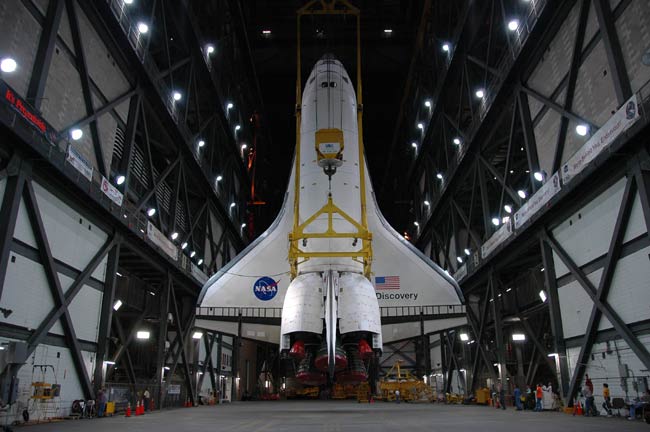Space Shuttle Discovery Moves Closer to Launch

NASA's space shuttle Discovery moved a step closer toward launch Monday as engineers worked to join the orbiter with the twin rocket boosters and fuel tank that will aid its flight into space next month.
Engineers hoisted Discovery up inside the cavernous Vehicle Assembly Building (VAB) today at the Kennedy Space Center in Cape Canaveral, Fla., to attach the 100-ton shuttle to its 15-story external fuel tank, said NASA spokesperson George Diller. The orbiter rolled over to the VAB from its protective hangar Sunday afternoon.
"We're in good shape to roll out to the launch pad on Sept. 30," Diller told SPACE.com.
Discovery's short trip to the VAB was delayed several days as NASA engineers replaced a leaky hydraulic seal and three others on a shock absorbing strut attached the orbiter's right main landing gear. The repair work went smoothly, allowing NASA to maintain the planned Oct. 23 launch target for Discovery's STS-120 construction mission to the International Space Station (ISS).
Shuttle workers used four of five padding days built into Discovery's launch preparation schedule to replace the hydraulic seals, leaving one extra day available for any future issues, Diller said.
Earlier this month, NASA engineers also completed work to trim away internal insulation layers from four of five brackets onDiscovery's foam-covered fuel tank after an X-ray survey found cracks in their cork-like material. Similar cracks may have led to the launch debris that dinged the underside of the shuttle Endeavour during its Aug. 8 liftoff, NASA officials have said.
Commanded by veteran NASA spaceflyer Pamela Melroy, Discovery's seven-astronaut crew will deliver a new connecting node to the ISS that will serve as the foundation for future international laboratories. The astronauts will also move an older solar array segment and test shuttle heat shield repair techniques during the five spacewalks planned during their 14-day mission.
Breaking space news, the latest updates on rocket launches, skywatching events and more!

Tariq is the award-winning Editor-in-Chief of Space.com and joined the team in 2001. He covers human spaceflight, as well as skywatching and entertainment. He became Space.com's Editor-in-Chief in 2019. Before joining Space.com, Tariq was a staff reporter for The Los Angeles Times covering education and city beats in La Habra, Fullerton and Huntington Beach. He's a recipient of the 2022 Harry Kolcum Award for excellence in space reporting and the 2025 Space Pioneer Award from the National Space Society. He is an Eagle Scout and Space Camp alum with journalism degrees from the USC and NYU. You can find Tariq at Space.com and as the co-host to the This Week In Space podcast on the TWiT network. To see his latest project, you can follow Tariq on Twitter @tariqjmalik.
